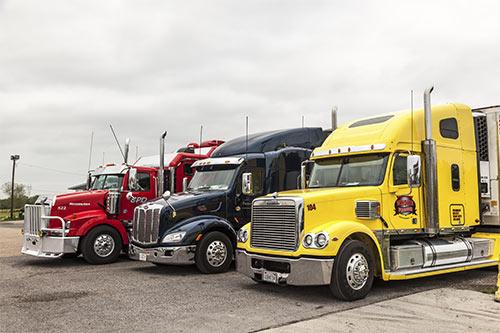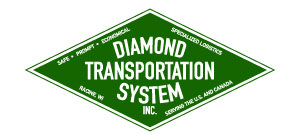List of Commercial Truck Axle Weight Limits by State
The importance of understanding commercial truck axle weight limits cannot be overstated. These limits are crucial for ensuring the safety of truckers, and other motorists, and the integrity of the roads and bridges they traverse. Overloading a semi-truck can lead to severe damage to infrastructure not designed to bear excessive weight, potentially causing hazardous conditions and costly repairs.
Why Axle Weight Limits Matter

State and federal authorities have established strict regulations for truck axle weight to address these concerns. Overloaded trucks can compromise the safety of bridges and overpasses, increasing the risk of structural failure. Thus, knowing and adhering to these weight limits is vital for maintaining road safety and preventing infrastructure damage. Overloaded trucks or semi trucks exert excessive pressure on roads and bridges, leading to accelerated wear and tear, potholes, and other forms of damage that can be costly to repair and hazardous to navigate.
State-Specific Standards
Every state has its own set of standards for the maximum weight allowed on a single axle, double axle, and tridem axle for commercial trucks. These rules ensure that large trucks are carrying their weight properly. This helps to decrease road damage and improve safety for all drivers.
For example, some states allow higher weight limits on certain roads, considering factors like road conditions, weather patterns, and traffic volumes. Understanding these state-specific regulations is essential for truckers to avoid penalties and ensure their loads are legally compliant.
The Role of the US Department of Transportation
The US Department of Transportation (USDOT) provides comprehensive information on truck axle weight limits, making it accessible to owner-operators and trucking companies. This information is essential for planning cross-country trips, and ensuring that cargo, tractor, and trailer weights comply with state regulations.
It’s important to note that the total gross weight of a truck and its cargo must not exceed 80,000 pounds, regardless of axle configuration. This federal standard helps maintain a baseline of safety and infrastructure protection across the country, but individual states may have additional restrictions or allowances.
Benefits of Compliance
Understanding and complying with these weight limits helps prevent fines, ensures safer travel, and protects the longevity of our roadways. Overloaded trucks are more likely to cause accidents, experience mechanical failures, and incur substantial penalties.
By adhering to the specified limits, trucking companies can maintain efficient and lawful operations. Compliance also reduces the risk of damage to public infrastructure, ultimately saving taxpayers money on repairs and maintenance. Moreover, operating within legal weight limits can extend the lifespan of the trucks themselves, reducing wear and tear on critical components such as brakes, tires, and suspension systems.
Planning for Cross-Country Trips

When planning cross-country trips, truckers must consider the varying weight limits across different states. This involves checking the regulations for each state they will pass through and ensuring that their loads are adjusted accordingly.
Some states have specific rules for different types of cargo. These rules apply to items such as farm products or dangerous materials. Each type of cargo has its own weight limits and safety regulations. Additionally, seasonal restrictions in some states may temporarily reduce weight limits on certain roads to protect them from damage during periods of thawing or heavy rainfall.
Detailed Weight Limits by State
Below is a detailed infographic and list of commercial truck axle weight limits by state, compiled for your convenience. This comprehensive guide provides the maximum allowable weights for single, double, and tridem axles across the United States. For instance, in Alabama, the maximum weight for a single axle is 20,000 pounds, while in Connecticut, it is 22,000 pounds. Knowing these variations helps truckers plan their routes effectively, avoiding fines and ensuring compliance with state laws.
State-by-State Commercial Truck Axle Weight Limits
Alabama
Single Axle: 20,000 lbs.
Double Axle: 34,000 lbs.
Tridem Axle: 42,000 lbs.
Gross Weight 80,000 lbs.
Alaska
Single: 20,000 lbs.
Double: 38,000 lbs.
Tridem: 42,000 lbs.
Gross Weight: Per FBF
Arizona
Single: 20,000 lbs.
Double: 34,000 lbs.
Tridem: Per state weight table
Gross Weight: 80,000 lbs.
Arkansas
Single: 20,000 lbs.
Double: 34,000 lbs.
Tridem: 50,000 lbs.
Gross Weight: 80,000 lbs.
California
Single: 20,000 lbs.
Double: 34,000 lbs.
Tridem: Undefined
Gross Weight: 80,000 lbs.
Colorado
Single: 20,000 lbs.
Double: 36,000 lbs.
Tridem: Per FBF
Gross Weight: 80,000 lbs.
Connecticut
Single: 22,000 lbs.
Double: 36,000 lbs.
Tridem: Per FBF
Gross Weight: 80,000 lbs.
Delaware
Single: 20,000 lbs.
Double: 34,000 lbs.
Tridem: 60,000 lbs.
Gross Weight: 80,000 lbs.
District of Columbia
Single: 21,000 lbs.
Double: 37,000 lbs.
Tridem: Per district weight table
Gross Weight: 79,000 lbs.
Florida
Single: 20,000 lbs.
Double: 40,000 lbs.
Tridem: Per FBF
Gross Weight: 80,000 lbs.
Georgia
Single: 20,340 lbs.
Double: 34,000 lbs.
Tridem: Per FBF
Gross Weight: 80,000 lbs.
Hawaii
Single: 22,500 lbs.
Double: 34,000 lbs.
Tridem: 42,500 lbs.
Gross Weight: 80,000 lbs.
Mississippi
Single: 20,000 lbs.
Double: 34,000 lbs.
Tridem: Per state weight table
Gross Weight: 80,000 lbs.
Missouri
Single: 20,000 lbs.
Double: 34,000 lbs.
Tridem: Per state weight table
Gross Weight: 80,000 lbs.
Idaho
Single: 20,000 lbs.
Double: 34,000 lbs.
Tridem: Per state weight table
Gross Weight 80,000 lbs.
Illinois
Single: 20,000 lbs.
Double: 34,000 lbs.
Tridem: 42,500 lbs.
Gross Weight 80,000 lbs.
Indiana
Single: 20,000 lbs.
Double: 34,000 lbs.
Tridem: 50,000 lbs.
Gross Weight: 80,000 lbs.
Iowa
Single: 20,000 lbs.
Double: 35,000 lbs.
Tridem: Per state weight table
Gross Weight: 80,000 lbs.
Kansas
Single: 20,000 lbs.
Double: 34,000 lbs.
Tridem: 43,500 lbs.
Gross Weight: 80,000 lbs.
Kentucky
Single: 20,000 lbs.
Double: 34,000 lbs.
Tridem: 48,000 lbs.
Gross Weight: 80,000 lbs.
Louisiana
Single: 20,000 lbs.
Double: 34,000 lbs.
Tridem: 42,000 lbs.
Gross Weight: 80,000 lbs.
Maine
Single: 20,000 lbs.
Double: 34,000 lbs.
Tridem: 45,000 lbs.
Gross Weight: 80,000 lbs.
Maryland
Single: 20,000 lbs.
Double: 34,000 lbs.
Tridem: Per state weight table
Gross Weight: 80,000 lbs.
Massachusetts
Single: 18,000 lbs.
Double: 34,000 lbs.
Tridem: Per state weight table
Gross Weight: 80,000 lbs.
Michigan
Single: 20,000 lbs.
Double: 34,000 lbs.
Tridem: Per state weight table
Gross Weight: 80,000 lbs.
Minnesota
Single: 10,000 lbs.
Double: 34,000 lbs.
Tridem: 42,000 lbs.
Gross Weight: 80,000 lbs.
Montana
Single: 20,000 lbs.
Double: 34,000 lbs.
Tridem: Per state weight table
Gross Weight: 80,000 lbs.
Nebraska
Single: 20,000 lbs.
Double: 34,000 lbs.
Tridem: Per state weight table
Gross Weight: 80,000 lbs.
Nevada
Single: 20,000 lbs.
Double: 34,000 lbs.
Tridem: Per state weight table
Gross Weight: 80,000 lbs.
New Hampshire
Single: 20,000 lbs.
Double: 34,000 lbs.
Tridem: Per state weight table
Gross Weight: 80,000 lbs.
New Jersey
Single: 20,000 lbs.
Double: 34,000 lbs.
Tridem: Axle N/A
Gross Weight: 80,000 lbs.
New Mexico
Single: 21,600 lbs.
Double: 34,200 lbs.
Tridem: Per state weight table
Gross Weight: 80,000 lbs.
New York
Single: 20,000 lbs.
Double: 34,000 lbs.
Tridem: Per FBF
Gross Weight: 80,000 lbs.
North Carolina
Single: 20,000 lbs.
Double: 38,000 lbs.
Tridem: Per state weight table
Gross Weight: 80,000 lbs.
North Dakota
Single: 20,000 lbs.
Double: 17,000 lbs.
Tridem: Per FBF
Gross Weight: 80,000 lbs.
Ohio
Single: 20,000 lbs.
Double: 34,000 lbs.
Tridem: Per FBF
Gross Weight: 80,000 lbs.
Oklahoma
Single: 20,000 lbs.
Double: 34,000 lbs.
Tridem: Per state weight table
Gross Weight: 80,000 lbs.
Oregon
Single: 20,000 lbs.
Double: 34,000 lbs.
Tridem: Per state weight table
Gross Weight: 80,000 lbs.
Pennsylvania
Single: 20,000 lbs.
Double: 34,000 lbs.
Tridem: Per state weight table
Gross Weight: 80,000 lbs.
Rhode Island
Single: 22,400 lbs.
Double: 36,000 lbs.
Tridem: N/A
Gross Weight: 80,000 lbs.
South Carolina
Single: 10,000 lbs.
Double: 35,200 lbs.
Tridem: Per state weight table
Gross Weight: 80,000 lbs.
South Dakota
Single: 20,000 lbs.
Double: 34,000 lbs.
Tridem: Per FBF
Gross Weight: 80,000 lbs.
Tennessee
Single: 20,000 lbs.
Double: 34,000 lbs.
Tridem: 54,000 lbs.
Gross Weight: 80,000 lbs.
Texas
Single: 20,000 lbs.
Double: 34,000 lbs.
Tridem: N/A
Gross Weight: 80,000 lbs.
Utah
Single: 20,000 lbs.
Double: 34,000 lbs.
Tridem: N/A
Gross Weight: 80,000 lbs.
Vermont
Single: 20,000 lbs.
Double: 34,000 lbs.
Tridem: N/A
Gross Weight: 80,000 lbs.
Virginia
Single: 20,000 lbs.
Double: 34,000 lbs.
Tridem: N/A
Gross Weight: 80,000 lbs.
Washington
Single: 20,000 lbs.
Double: Per state weight table
Tridem: N/A
Gross Weight: 80,000 lbs.
West Virginia
Single: 20,000 lbs.
Double: 34,000 lbs.
Tridem: Per FBF
Gross Weight: 80,000 lbs.
Wisconsin
Single: 20,000 lbs.
Double: 34,000 lbs.
Tridem: Per state bridge formula
Gross Weight: 80,000 lbs.
Wyoming
Single: 20,000 lbs.
Double: 34,000 lbs.
Tridem: 42,000 lbs.
Gross Weight: 80,000 lbs.
Conclusion
This list is essential for anyone involved in the transportation industry, offering a quick reference to ensure that all trips are planned within legal weight restrictions. By following these guidelines, truckers can contribute to safer roads and a more reliable transportation network. The adherence to truck axle weight limits not only ensures legal compliance but also promotes the sustainability of our infrastructure, enhancing the safety and efficiency of freight transport across the nation.

Understanding and adhering to commercial truck axle weight limits is a crucial aspect of responsible trucking. It protects the safety of drivers and other road users, preserves the integrity of infrastructure, and ensures the smooth operation of transportation networks. By staying informed about these regulations and planning accordingly, truckers can play a vital role in maintaining the safety and efficiency of our nation’s roads.
Reader interactions
3 Replies to “List of Commercial Truck Axle Weight Limits by State”
Comments are closed.
















[…] lbs. threshold, 14′ wide, 14’6″ high and 110’ long. In 2017, before UPT was launched, 20 states met that threshold, with another 10 having some form of automated permitting in place. Since then, another 6 […]
[…] Official Site: https://osagespecial.com/2020/03/truck-axle-legal-weight-limits/ […]
[…] Official Site: https://osagespecial.com/2020/03/truck-axle-legal-weight-limits/ […]